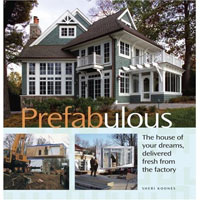This is the only book that gives homeowners who are dreaming about building or planning to build a new home the good and the bad on all types of prefabricated houses. It shows that prefabricated can be a mainstream traditional design and does not have to look like a mobile home or a modular "Dwell" box.
We do not strictly control Google ad content. If you believe any Google ad is inappropriate, please email us directly here.
Prefabulous describes the many systems available for prefabricating all or parts of a new home, including timber frame and log, as well as modular, panelized, structural insulated panels, steel framing and concrete systems, which are relatively new. Prefabulous describes these systems, compares their advantages and disadvantages, and shows beautiful examples of houses built using these techniques. Although all of these "prefabricated" houses look very different, all of them were manufactured partially or almost completely in a controlled factory environment and transported to the home site to be erected. As a group these systems offer a faster, more energy-efficient, and sometimes more cost-efficient method of building.
Includes a foreword by Not So Big House author Sarah Susanka, who writes: "For homeowners who want to know the options, the advantages and disadvantages of those options, and to see how those prefabricated parts come together into a good, attractive home, read this book."
Author comments: I'm very excited with the release of Prefabulous because I believe there is a general confusion about prefabricated terms and a stigma attached to prefab in general. I hope this book will clear up some of that confusion by describing 7 different types of prefab construction, and shed new light on this wonderful way of building a house. The houses profiled in this book are quite varied in size, style, and method of construction, but all of them were built in part or almost totally in a factory.
In today's world I believe we are all concerned about preserving our resources and saving energy - prefab construction is an excellent option towards both of those ends. I have always hoped to be an advocate for the homeowner, providing options to help them make the best possible construction decisions. I believe that those people who are now aware of their prefab options will decide to build their own home using one of these methods. When I speak with groups of people about prefab and show them pictures of some of the houses that have been built using prefab methods - inevitably someone will ask - if this is so wonderful, how come all houses aren't built this way? The answer is: They just don't know about these methods. For the time being, it's one of the best kept secrets.
HHI Error Correction Policy
HHI is committed to accuracy of content and correcting information that is incomplete or inaccurate. With our broad scope of coverage of healthful indoor environments, and desire to rapidly publish info to benefit the community, mistakes are inevitable. HHI has established an error correction policy to welcome corrections or enhancements to our information. Please help us improve the quality of our content by contacting allen@healthyhouseinstitute.com with corrections or suggestions for improvement. Each contact will receive a respectful reply.
The Healthy House Institute (HHI), a for-profit educational LLC, provides the information on HealthyHouseInstitute.com as a free service to the public. The intent is to disseminate accurate, verified and science-based information on creating healthy home environments.
While an effort is made to ensure the quality of the content and credibility of sources listed on this site, HHI provides no warranty - expressed or implied - and assumes no legal liability for the accuracy, completeness, or usefulness of any information, product or process disclosed on or in conjunction with the site. The views and opinions of the authors or originators expressed herein do not necessarily state or reflect those of HHI: its principals, executives, Board members, advisors or affiliates.









